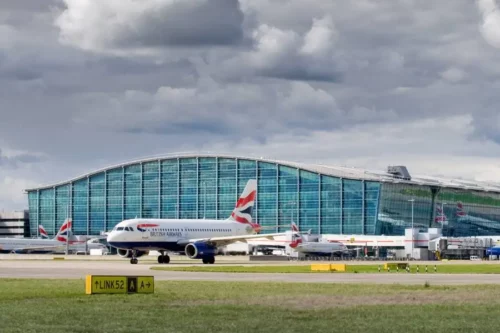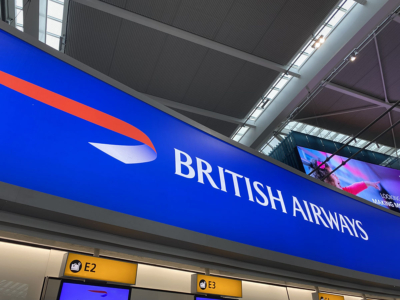British Airways turns a corner with record punctuality in February 2025
Links on Head for Points may support the site by paying a commission. See here for all partner links.
Sean Doyle’s turnaround of the airline appears to be bearing fruit, at least in terms of punctuality.
British Airways has swept into fourth position for punctuality amongst ‘global’ airlines and sixth place amongst all carriers in Europe. It had an on-time performance of 86.9% for February. This is using data on arrival times from Cirium, the aviation analytics company.
(If you’re wondering how you can be 4th in the world but 6th in Europe, the ‘global’ rankings are restricted to carriers which serve at least three continents. Small carriers are excluded from consideration on both lists.)
This is the first time in an ‘extended period’ that a UK airline has made Cirium’s Top 10.
BA’s own numbers show that it achieved an average of 72.7% on-time performance for the whole of 2024 compared to 60.4% in 2023. The best result was in the first quarter of 2024, with an average 79.1% of flights departing within 15 minutes of the scheduled time.
The British Airways press office did not respond to requests for comment. However, in a message to staff, Tom Moran, Director of Heathrow for British Airways said performance at its Heathrow hub in February was even better than Cirium’s numbers.
Using BA’s definitions, the airline set a new punctuality record of 90% in February, beating the previous record of 89% set in April 2017 and the internal target of 80%. “We also hit our monthly target for baggage and in terms of customer connections, February was our best month since the pandemic.”
In the industry, ‘on time performance’ is considered departing or arriving within 15 minutes of schedule. A flight scheduled to depart at 15:00 would therefore be considered ‘on time’ if it departed at 15:14 or earlier.
You should note that, according to Flyertalk reports, part of the improvement in BA’s own numbers (as opposed to the Cirium data which is independently collected) is down to BA redefining ‘departure’. This is now captured when the parking break is released, and due to ATC delays or runway queues there is little connection between this and ‘wheels up’.
The Cirium data shows that the BA improvements are ‘real’, however. Other airlines in Cirium’s Top 10 Global Airlines include Aeromexico (92.87%), Iberia (91.25%), Qatar Airways (87.23%), Lufthansa (86.66%), Saudia (86.20%), Avianca (84.86%), Hainan Airlines (82.41%), LATAM (81.97%) and Emirates (80.76%).
British Airways has struggled with on-time performance since the pandemic when it let go tens of thousands of experienced staff. It has also had to scale back overly-ambitious summer schedules in recent years due to resource constraints.
What is driving the improvements?
British Airways has touted numerous investments it is making as part of a £7 billion investment strategy. Whilst the majority of that will be spent on replacement aircraft, a not insignificant amount has been spent on modernising its operational systems and IT services.
This includes a ‘full transition’ to ‘modern core operational systems’ as well as a brand new ‘Operations Control Centre’, both of which help staff to ‘make better, data driven decisions.’
The question now is whether British Airways can keep it up. Flight punctuality typically dips during the peak summer months as airlines push aircraft and schedules to their limits. This in turn reduces redundancy and the ability to recover quickly from adverse events such as poor weather, aircraft outages or air traffic control strikes.

Last year, British Airways suffered from a self-described ‘difficult’ summer thanks to air traffic control strikes and aircraft availability. Reliability of the twelve A380s in BA’s fleet was particularly poor and the airline operates a large fleet of Boeing 787s which have been dogged by Rolls-Royce engine issues.
There is light at the end of the tunnel. IAG CEO Luis Gallego said recently that Rolls-Royce is rolling out an engine durability package “very soon” which he hopes will “double the time on wing” or, in layman’s terms, the time before it needs substantial maintenance. British Airways is the only airline at IAG to operate Boeing 787s and Gallego said the improvements will be “very positive for the business.”
In truth, the figures for the whole of 2025 to date are less impressive.
Cirium data shows that BA’s performance in January 2025 was actually below that of January 2024. However, February was very strong and Rob’s flight back from the ITB travel fair in Berlin last Wednesday arrived 35 minutes early! Whether it is January or February which is the outlier will become clear in the coming months.
Sister airline Iberia also remains well ahead of BA with 91% punctuality in February.
If British Airways can keep the improvement up then year-end punctuality could be close to 80%, a marked improvement of 20 percentage points in two years. This would be a win for both the airline and its passengers – and no mean feat at a congested airport like Heathrow where the busier it gets, the harder it is to maintain on-time performance.
PS. If you are not a regular Head for Points visitor, why not sign up for our FREE weekly or daily newsletters? They are full of the latest Avios, airline, hotel and credit card points news and will help you travel better. To join our 70,000 free subscribers, click the button below or visit this page of the site to find out more. Thank you.

How to earn Avios from UK credit cards (July 2025)
As a reminder, there are various ways of earning Avios points from UK credit cards. Many cards also have generous sign-up bonuses!
In February 2022, Barclaycard launched two exciting new Barclaycard Avios Mastercard cards with a bonus of up to 25,000 Avios. You can apply here.
You qualify for the bonus on these cards even if you have a British Airways American Express card:

Barclaycard Avios Plus Mastercard
Get 25,000 Avios for signing up and an upgrade voucher at £10,000 Read our full review

Barclaycard Avios Mastercard
Get 5,000 Avios for signing up and an upgrade voucher at £20,000 Read our full review
There are two official British Airways American Express cards with attractive sign-up bonuses:

British Airways American Express Premium Plus Card
30,000 Avios and the famous annual Companion Voucher voucher Read our full review

British Airways American Express Credit Card
5,000 Avios for signing up and an Economy 2-4-1 voucher for spending £15,000 Read our full review
You can also get generous sign-up bonuses by applying for American Express cards which earn Membership Rewards points. These points convert at 1:1 into Avios.

American Express Preferred Rewards Gold Credit Card
Your best beginner’s card – 20,000 points, FREE for a year & four airport lounge passes Read our full review

The Platinum Card from American Express
50,000 bonus points and great travel benefits – for a large fee Read our full review
Run your own business?
We recommend Capital on Tap for limited companies. You earn points worth 0.8 Avios per £1 on the FREE standard card and 1 Avios per £1 on the Pro card. Capital on Tap cards also have no FX fees.

Capital on Tap Visa
NO annual fee, NO FX fees and points worth 0.8 Avios per £1 Read our full review

Capital on Tap Pro Visa
10,500 points (=10,500 Avios) plus good benefits Read our full review
There is also a British Airways American Express card for small businesses:

British Airways American Express Accelerating Business Card
30,000 Avios sign-up bonus – plus annual bonuses of up to 30,000 Avios Read our full review
There are also generous bonuses on the two American Express Business cards, with the points converting at 1:1 into Avios. These cards are open to sole traders as well as limited companies.

The American Express Business Platinum Card
50,000 points when you sign-up and an annual £200 Amex Travel credit Read our full review

The American Express Business Gold Card
20,000 points sign-up bonus and FREE for a year Read our full review
Click here to read our detailed summary of all UK credit cards which earn Avios. This includes both personal and small business cards.





 Rob
Rob 





Comments (71)